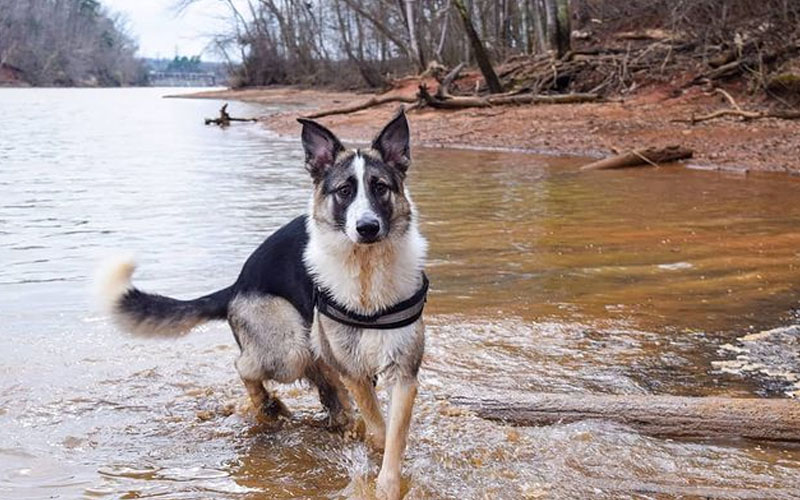The ever-loyal black german shepherd is probably the most popular dog breed among pet lovers. They are famous for their loyal, protective, loving, and caring personality.
But, do you know that besides the usual black and tan coat, they have other color varieties? Yes! We are talking about the rare tan, black, and white Panda German Shepherd.
A German shepherd puppy that got popular in the canine world for its unique appearance. So, without further ado, let’s find out what a panda German shepherd is?
Table of Contents
Panda German Shepherd

A panda German shepherd is a rare piebald German shepherd dog with a white hue in its coat, whereas the amount of white on the fur varies from dog to dog. (we’ll explain the reason later in our guide)
This tricolor skin gives them a look of a panda bear, hence named panda German shepherd.
However, it is not always necessary for a typical German shepherd to show panda-like colors. In fact, this black and white hue can appear on blue, black, white, or any other types of GSD dogs.
The white patches are usually around their round face, tail tip, abdomen, collar, or chest, whereas other spots are of the usual black and tan color, just like a typical German shepherd.
But, what’s the reason behind their unique coat color? Is it a healthy canine? Is it a good family pet or shows aggressive behavior?
Let’s find the answers to these and some of the most asked questions about the panda shepherd below:
Why German Shepherd Panda Have a Black and White Coat?
Panda German Shepherd is a purebred GSD with a tan, black and white coat. A panda puppy with this exceptional fur color is mainly born due to a mutation in its genetics. Yes!
The mutation in the K.I.T. genes were reported to be the source of their black and white coat. However, the history of panda dogs is not that old, and they were first reported in 2000.
According to a white spotting test by UCDavis, only a German shepherd dog with N/P genotype can transmit panda coloring to their offspring.
(N: Normal Allele, P: Panda Coloring Allele)
The study concluded that a cross of two GSD’s with normal and panda alleles would have the chance to transmit the mutation in 50% of the litter they produced.
Moreover, the fur color of all the panda dogs depends on their genetics or the characteristics of breeds mated to produce them.
You must be thinking about the amount of white color panda German shepherd puppy will have, like, 35%, 50%, or even more.
Well, honestly, you never know. Why?
Because the cause of piebald German shepherds is a mutation or alteration in the gene sequencing.
Is Black and White German Shepherd Real?
Yes, it surely is, but just like the rare azurian husky, it can be quite hard to find panda dogs as they have a unique coat color than the traditional German shepherd dogs.
The first to ever exist was Lewcinka’s Franka Von Phenom, a female panda German shepherd, a pup to two pure GSD working line canines.
Where Panda GSD Originated?
On October 4, 2000, Cindy Whitaker of the United States unknowingly became the breeder of the first panda shepherd.
She bred the sire (Brain vom Wölper Löwen SCHH III) and dam (Cynthia Madchen Alspach) purebred German shepherds.
Franka or Frankie was the only pup to have symmetrical white spots. However, she couldn’t get the same results when she tried to breed the dogs again.
What does a Panda German Shepherd Look Like?

The rare panda shepherd is a stunning dog that looks as captivating as a panda bear.
They have a thick, dense tricolor coat, piercing almond-shaped blue eyes, long bushy tail, upright ears, round face, black nose, robust and muscular body.
Note: The color of their nose can also be liver (reddish-brown) or blue.
German shepherd panda dogs have a strong light bone structure and are one of the graceful GSD dogs.
Eye Color
A panda German shepherd puppy has beautiful almond-shaped eyes. Their eye color is usually blue but can also have brown or slight China eyes (blue eyes flecked with light blue or white).
Height
The average height range for a panda German shepherd is between 22 inches to 26 inches (56cm-66cm).
Whereas the stunning panda shepherds are 24 to 26 inches (61cm-66cm) tall for male dogs and 22 to 24 inches (56cm-61cm) tall for female canines.
Size and Weight
Purebred panda German shepherds are naturally big dogs, just like huskies with an average weight between 53 to 95 pounds.
For a tricolor male panda canine, the weight is approximately 75 to 95 pounds. However, a black and white piebald female panda dog usually lies within a range of 53 to 75 pounds.
Are Panda German Shepherds Rare?
Yes, Panda GSD dog is one of the rarest German shepherds to exist—the reason being the mutated gene and panda pattern not to be found in the GSD history.
And, as the white spots are usually considered a fault, not many breeders have tried to produce the panda shepherds via breeding.
Note: Click to read about a rare Lycan shepherd, a mix between working line GSD, blue bay shepherd, and Belgian Malinois.
Are Panda Dogs Purebred or Mixbred?
The breeder, Cindy took the female panda shepherd for D.N.A. testing to the veterinarian genetics laboratory, and the tests came out positive as yes, it was surely a purebred and a complete offspring of the two German shepherds.
No, they are not mix-bred as both the dogs used in the breeding had no white markings.
What Are the Personality Traits of Purebred German Shepherd Panda?

Purebred panda German shepherd is a colored variation of the typical German shepherd dogs. So, one can expect them to have the similar personality traits as their parents. Here are some of the highlight characteristics of panda dogs:
- Loyal
- Intelligent
- Devoted
- Protective
- Trustworthy
- Playful
- Active
- Guard dogs
- Loving
- Affectionate
- Alert
However, how well these traits will be prominent in your dog’s personality depends on their training, socializing, and care.
Is Panda Shepherd Dog Aggressive?
German shepherds are often used as police dogs, and the parents of panda shepherds were also from working line GSDs. It is natural to think of them as some aggressive breed.
However, the reality is quite the opposite. Yes!
They are often misunderstood as aggressive dogs like black pitbull when their temperament actually depends on their training, behavioral commands, and early socialization.
Yes, their bad behavior is due to their poor training!
What Are the Food Requirements for Panda Dogs?

They need a high protein food diet to match their high energy and active nature.
You can also use the raw feeding method or incorporate vegetables, fruits, and snack treats in their daily meals to provide carbohydrates, vitamins, fats, minerals, and other nutrients essential for their good health.
Note: Click to find 43 human snack options to feed your lovely pooch.
The feeding requirement of a panda shepherd puppy and mature panda German shepherd varies as a growing pup needs to eat more meals than an older canine.
But, one should never overfeed the dog as it may lead to obesity and other health problems.
Is Panda German Shepherd an Easy Keeper?
Yes! Their grooming care needs are similar to any other German shepherd dog:
They have a thick and dense coat that heavily sheds during the season. To maintain the beauty of their fur, the owner needs to brush the coat daily or at least every other day of the week.
They also need regular cleaning of paws, trimming of nails, checking of ears and eyes. However, they need to be bathed only when the fur seems dirty, or it may cause skin irritation.
Note: Click to find effective and useful pet supplies that can help maintain your dog’s daily grooming, training, caring, and feeding needs.
Is Piebald Colored German Shepherd Trainable?

Yes, panda colored German shepherd is partially trainable.
However, it has high training needs and demands an active household. A daily exercise of 2 hours will suffice their energetic nature.
It is advised to start socializing them as early as possible to get the best behavior.
Pro-Tip: Play a fetch-ball game daily to keep them entertained. Click to get a manual ball launcher to make the training easy for you.
Are Panda German Shepherd Puppies Healthy Canines?
There is no uncertain health problem reported for the panda German shepherd puppies. However, just like any other breed, they also are prone to some health problems:
- Arthritis
- Degenerative Myelopathy
- Hip dysplasia
- Heart issues
- Epilepsy
- Dwarfism
- Chronic eczema
- Elbow dysplasia
- Blood disorders
- Digestion Problem
- Allergies
- Inflammation of cornea
Pro-Tip: If you plan to adopt a panda German shepherd pup, make sure to precheck its health from a vet to detect any diseases, allergies, or infections beforehand.
Are German Shepherd and Panda German Shepherd the Same Dogs?

If we compare their breed types, you can say panda German shepherds and usual German shepherds are the same canines.
But if we take their coat color and pattern into consideration, then no, they are not.
To put it in one sentence, panda German shepherd is a GSD-type dog with a different coat pattern.
Are Panda German Shepherd Puppies Good Family Dogs?

Yes! German shepherd panda from the Franka lineage can be a great family dog if trained and socialized properly from an early age.
A well-trained and well-behaved panda pup is friendly with children and pet dogs but may be aloof with strangers.
Is Panda German Shepherd A.K.C. Registered?
There are more than 5 types of German shepherd colors, but only a few are registered with the A.K.C. Moreover, it can take years for the club to recognize any new dog breed or type.
The white hue is usually taken as a fault or a problem which can be a major reason why panda German shepherd is not a registered dog by American Kennel Club.
Is Panda German Shepherd Puppy Available for sale?
Yes, it is available for adoption, but as they are a rare variety of working-line GSD, most breeders charge a high price for them. An average price ranges from $1000 to $3100.
Pro-Tip: Always check the documentation of the breeder before adopting the puppy.
Conclusion
Panda German shepherd is not an ideal dog for a person who just wants it for its beauty and unique coat color.
It may also be not suitable for first-time owners, but surely with proper care, training, and socialization, it can be the best pest one can adopt!

